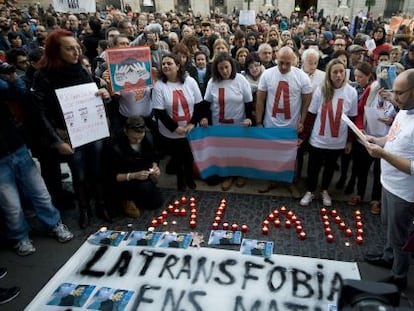Legal precedent brings hope to families of transgender children
New case in Valencia showcases the shortcomings of legislation that puts limits on Civil Registry changes


At age six, María does not want to be an astronaut, an inventor or a superhero like his siblings. Instead, he wants to be a girl.
His mother, Ana Navarro, remembers when she realized that her little boy Mario was in fact María.
If we escape the labels, we’re left with the person. Now I see that María is happy
Ana Navarro
“If I look back and think about the moment that it became manifest that he was a girl, I would say that since the very beginning,” she says. “I remember her at age two playing roles that are socially associated with women. When she began to speak, every day she would repeat that when she grew up she would be a girl and that her name would be María.”
Ana continues with her child’s story.
“At night I would go online to find information, because I’d been educated to believe that boys are boys because they have a penis and girls and girls because they have a vulva,” she recalls. “He did not look happy, he was not the radiant child that he should have been at that age. He was very shy, and I could see something was amiss...”
Navarro, a 38-year-old psychologist and mother of five, eventually found an article by a contributor from the Daniela Foundation. She got in touch with the association, which helped her to understand what was going on with her child, and to take the first steps.
Sign up for our newsletter
EL PAÍS English Edition is launching a weekly newsletter. Sign up today to receive a selection of our best stories in your inbox every Saturday morning. For full details about how to subscribe, click here.
“One day, at dinner time, we said that we knew a girl with a penis, and there was a dialogue with my older daughters while the little one listened. I told all five of them that we were going to redecorate their rooms, and asked them to draw a self-portrait so we could print it out and hang it from the wall. And María drew herself the way she is: a girl with a dress, long hair and a girl’s name. I remember when he handed me the notebook I said ‘Oh, Mario, you look very nice with long hair,’ and he looked up and said very earnestly, ‘I’m going to be a girl, I really am.’ He was five years old.”
María’s family began communicating this reality to the people around them. “On a Friday he left school as Mario, and the following Monday he showed up as María, wearing his uniform pinafore dress. There was no problem,” says Navarro, underscoring that the school, Vírgen de Cortes de Valencia, made it easy for them.
“It’s the environment that lets a person express themselves freely. People tend to confuse identity with genitalia,” she adds.
The legal battle
To wage the legal battle, María’s family will use the recent precedents set by two judges who authorized an official name and gender change at the Valencia Civil Registry for two minors without the need to accredit a two-year medical treatment, as stipulated by law.
The lawyer who managed both cases, Ana Cañizares of Vivar&Asociados, says that “it is a precedent for other civil registries in Spain, which for the most part have never dealt with a request for a child gender change and do not know how to deal with it.”
“We think there is a lack of knowledge, and even fear, among Civil Registry judges,” she adds.
Nine regions with special units
There are nine regions in Spain with public departments to handle gender identity and transgender issues: Asturias, Basque Country, Navarre, Aragon, Catalonia, the Valencia region, Madrid, Andalusia and the Canary Islands.
The most recent figures, dating back to late 2014 and contributed by these regions, show that 4,459 transgender individuals used these services, of whom 10% were minors.
By extrapolating these figures, in Spain there could be one biological male who feels like a woman for every 9,665 to 21,031 males, explains Hurtado. Inversely, there is one biological female who feels like a man for every 15,456 to 48,096 females.
In March, the Supreme Court questioned the existing veto on name changes for transgender children, and raised a question of unconstitutionality regarding the need for individuals to be of legal age before applying for such changes.
The fact that transgender minors bear ID listing a gender that does not match the way they feel “ was causing many demeaning and painful situations in such everyday activities as using the bathroom or the dressing room in school, going to camp and so on,” says the lawyer Juan Antonio Vivar, adding that some of the minors he has represented had used white-out to blot out their own names and pictures on their ID cards.
“The unknown is scary to us, but it’s easy,” says María’s mother. “If we escape the labels, we’re left with the person. Now I see that María is happy.”
And now that María already feels like a girl, when she’s asked what she wants to be when she grows up, she replies that she’s going to be a riding school instructor. She loves horses.
English version by Susana Urra.
Tu suscripción se está usando en otro dispositivo
¿Quieres añadir otro usuario a tu suscripción?
Si continúas leyendo en este dispositivo, no se podrá leer en el otro.
FlechaTu suscripción se está usando en otro dispositivo y solo puedes acceder a EL PAÍS desde un dispositivo a la vez.
Si quieres compartir tu cuenta, cambia tu suscripción a la modalidad Premium, así podrás añadir otro usuario. Cada uno accederá con su propia cuenta de email, lo que os permitirá personalizar vuestra experiencia en EL PAÍS.
¿Tienes una suscripción de empresa? Accede aquí para contratar más cuentas.
En el caso de no saber quién está usando tu cuenta, te recomendamos cambiar tu contraseña aquí.
Si decides continuar compartiendo tu cuenta, este mensaje se mostrará en tu dispositivo y en el de la otra persona que está usando tu cuenta de forma indefinida, afectando a tu experiencia de lectura. Puedes consultar aquí los términos y condiciones de la suscripción digital.
More information
Últimas noticias
Chris Martin, Taylor Swift, Elijah Wood and other famous wedding ‘crashers’
‘How does it feel to be a failure?’: Elizabeth Berkley’s journey from ‘Showgirls’ ridicule to vindication
The story of the Málaga virus: The code that haunted Google’s cybersecurity center director for 30 years
The impact of Ecuador’s mega-prison: A polluted river, cleared forests and military checkpoints
Most viewed
- Christian Louboutin: ‘Young people don’t want to be like their parents. And if their parents wear sneakers, they’re going to look for something else’
- The low-cost creative revolution: How technology is making art accessible to everyone
- All the effects of gentrification in one corner of Mexico’s Colonia Roma
- Liset Menéndez de la Prida, neuroscientist: ‘It’s not normal to constantly seek pleasure; it’s important to be bored, to be calm’
- December Social Security and SSI payments: Dates, double checks and the 2026 COLA increase










































